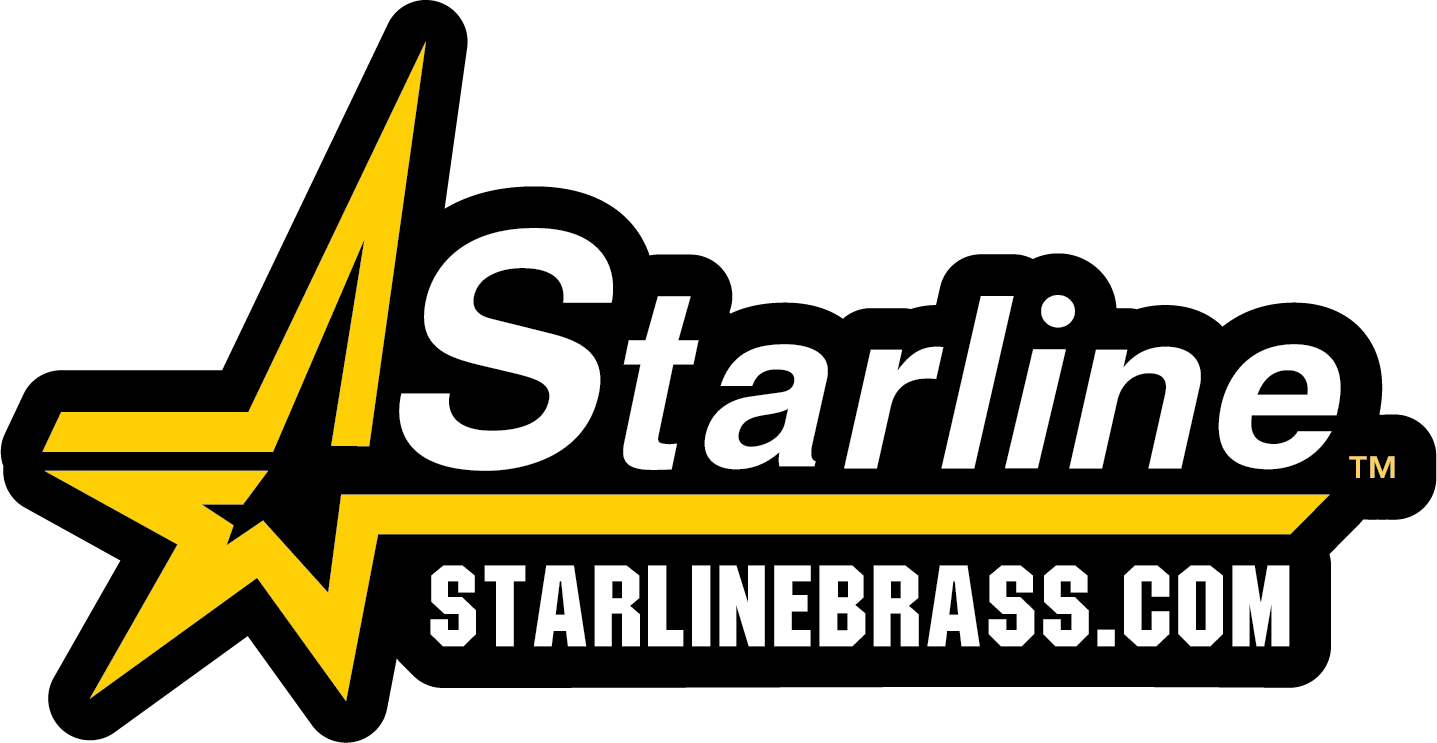Synopsis: Anyone who has worked with the 45-70 Government with loads using blackpowder, smokeless to match blackpowder performance, or smokeless loads at higher pressure, soon learns that this cartridge offers phenomenal performance. Indeed, it will forever remain unsurpassed as an overall short-range hunting round and long-range low-velocity target round. The list of other useful characteristics is long. In the following discussion, I will gloss over a few critical details and I will generalize, but the pertinent facts hold true.
Very few things develop in the vacuum; the 45-70 Government cartridge was no exception. The folks in the ordnance department of the US Cavalry were well aware of the best military cartridge developments worldwide and they were keenly aware of previous developments of Whitworth, in England. Whitworth took the muzzle-loading caplock rifle to a state of perfection that few modern shooters would believe possible.
This picture of the basic Whitworth rifle shows that it is similar to the Hawken and other period muzzle-loading caplock rifles in general layout. What Whitworth did was to perfect rifling and bullet designs and come up with a feasible method of attaching a telescopic sight that would allow convenient long-range shooting (he attached the scope to the left side of the gun, which eliminated the cheek weld problem and solved other problems).
Rather than chronicle that gun and the bullets Whitworth developed for it, I will merely note that Confederate marksmen using Whitworth rifles and rather crude telescopic sights came very close to turning the tide of that war. They took dozens of Union officers out of action with shots at distances approaching one mile. If the south had been able to afford more of Whitworth’s sniper rifles, and had it been able to get those guns through the blockades, there is no telling what might have happened.
Those Whitworth rifles were 45-caliber, fired a 500-grain round nose bullet from a barrel with a 20-inch twist, and used a carefully measured charge of 70 grains of the best blackpowder then available (Curtis and Harvey, Black Diamond). Likely for those reasons, when the US military realized the limitations of the 50-70 Government chambering, it simply adopted a chambering and cartridge that essentially duplicated the load used in Whitworth’s famous sniper rifle: 45-caliber, 70-grains of blackpowder, and 500-grain round nosed bullet. Springfield Armory even copied Whitworth’s twist rate.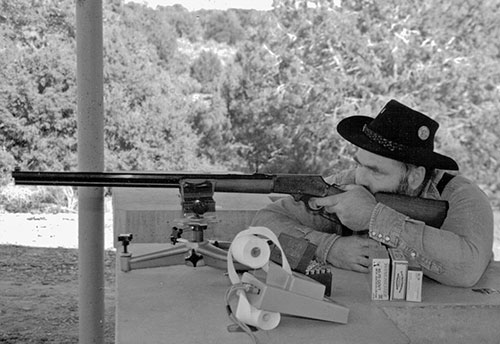
Posing with the Marlin 1895 CB: I tested this rifle with various factory loads and several of my favorite handloads. My handload using the Lyman 405-grain Flat Nose at 1300 fps put ten bullets through one ragged hole at 100 yards, with me using the factory iron sights. My friend, Mike Kelso, now owns this rifle and uses it, very successfully, both for Cowboy Action shooting and elk hunting. He assures me that it is not for sale!
The 45-70-500 Government had more developmental testing before the US Military adopted it for chambering in the Springfield rifle than any other US Military battle rifle chambering and cartridge combination has ever had. They fired literally tons of bullets down range, including penetration testing at 1700 yards. Nothing about the final standardized design of the 45-70-500 Government cartridge or rifle was left to chance. For example, elevation changes of the Buffington rear sight automatically account for bullet drift.
In my youth, folks still talked about the battle of the Little Bighorn with some fervor. It was claimed that one reason that Custer’s men could not hold the Indians off was that as the Trapdoor Springfields got hot (takes only a few shots with blackpowder loads). As the guns heated, the cases started sticking in the chamber and extraction became more difficult after each shot. Eventually, most of the guns were rendered useless (other than as clubs) when the extractors tore through the case rims, leaving the fired case stuck in the chamber. Immediately after that, and for generations thereafter, folks blamed this on poor extractor design. The truth is, the problem was the balloon-head cases, which had relatively weak rims anyway, combined with military fastidiousness, which required that the soldiers routinely use wool to polish the verdigris (pronounced: Vid-eh-Gree) off the brass cases (verdigris is the green corrosion of brass that occurs when it is stored in leather). As a result, Custer’s men went into battle with carry ammunition in which the rims were dangerously thinned by repeated, excessive cleaning.
Subsequent to adoption of the 45-70 by the military, numerous alternative loadings occurred. I touched upon some of those in the 8th and 9th Editions of Cartridges of the World. Generally, within the civilian market, these included loadings with the bullet seated differently (to alter overall length) using a different propellant charge, with bullets of different weights or nose profiles and designs, and (later) use of smokeless powder for greater energy. Military developments included the 45-56-405, carbine loading and 45-70-500, rifle loading, both the conventional round nose and a bullet with an explosive charge in the nose (for use in the Gatling Gun). Chronicling every military loading variation of this cartridge is far beyond the intended scope of this article.
Through it all, the original case design held. While the case was improved as the military arsenals switched from internally primed folded-rim (balloon-head) cases to externally primed folded-rim cases, then to semi-balloon-head cases, and possibly eventually to modern externally primed solid-head cases, external case rim and body dimensions never varied. (I do not know when solid-head cases first occurred but I believe that was long after the military officially retired the 45-70.) I have samples of both internally- and externally-primed 45-70 cases manufactured in the late 1870s and early 1880s. These fit a modern 45-70 shellholder perfectly. Excepting the brass embrittlement resulting from the use of fulminate of mercury as the energetic component of the primer, I could successfully reload these cases with modern dies and fire the resulting loads in a modern gun.
While the modern (solid-head) cases have less capacity, those also are much stronger and will tolerate loads generating much higher pressure. With the high-quality cartridge brass that Starline and other manufacturers now produce, these cases will last a careful handloader through many loading and firing cycles. With neck annealing, case life can be almost unlimited.
I knew a blackpowder silhouette competitor who used the same cases for more than 30 years. He calculated that he had used his select match cases more than 100 times without any maintenance or losses. Because of the moderate pressure of such loads, case sizing is not necessary. Most who compete in that game merely decap the case, clean it, dry it, seat a primer, charge it, and slip a bullet into the case mouth. Such loads function very similarly to modern benchrest loads. When the shooter closes the action on a chambered round, the breechblock drives the case forward, pushing the bullet into the rifling, slightly, while seating it to the final depth. This occurs similarly for each shot. While such loads are not mechanically robust enough for typical hunting use, these work just fine for target shooting.
Various companies have recently or are now offering loads that cover the 45-70 gamut, from blackpowder to smokeless blackpowder equivalent, to higher-pressure loads for the Marlin and other modern guns.
Currently, factory loads offered by the big three US manufacturers are limited to 300-grain jacketed bullets launched at about 1750-fps. Several aftermarket manufacturers offer loads ranging from original blackpowder duplication to serious medicine for any game animal on the planet. These include Cor-Bon, Buffalo Bore, and Garrett. These manufacturers often prefer to use Starline cases.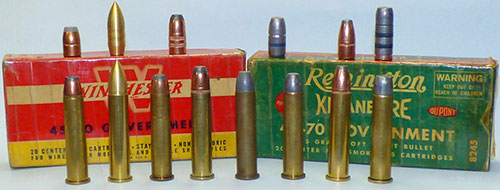
A few of the 45-70 loads and bullets from my archive, left-to right:
The 362-grain trans-sonic bullet brings the 45-70 fully into the modern era with a pointed nose design and which launches at about 2000 fps, yet remains stable throughout ballistic flight. 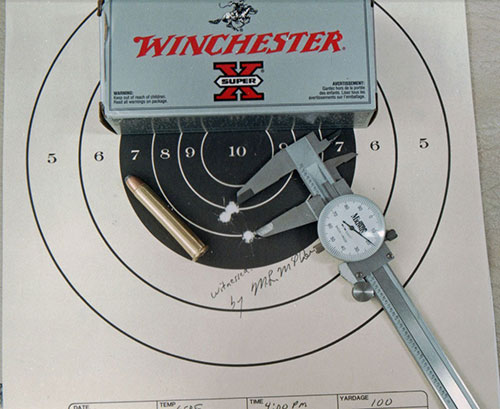
While my best handloads will generally shoot better, factory 45-70 ammunition is not too bad. My friend, Dave Livingston, fired this sub-3/4-inch, 100-yard group, using a factory-stock 1895 Marlin and the factory iron sights.
My first work with the 45-70 involved loading blackpowder rounds in semi-balloon-head cases, with bullets cast of wheel weights, using the Lyman 457125 mould. This bullet and these loads duplicated the original 45-70-500 loads. According to my rudimentary chronograph, velocity from an original Trapdoor Springfield was 1210 fps. Although recoil, especially when firing from the prone position was brutal, accuracy was impressive.
My next 45-70 experimentation was with a very early 1886 Winchester that PO Ackley had rebored and rechambered from 40-82 WCF to 45-70, so the late owner could actually use the gun. In those days, no one even considered the possibility that such a gun (in unaltered condition) might some day be a valuable collector’s item. The idea that any manufacturer would ever again make cases that anyone could use to make 40-82 ammunition was equally inconceivable.
The owner of that Winchester wanted a serious load. He settled upon 51 grains of IMR 3031 behind the Lyman 457125 bullet, seated to take advantage of the full length of the action in that gun (about 2.75-inches). That load generated right at 1800 fps and very close to 33,000-psi peak chamber pressure, which significantly exceeds the 28,000-psi peak pressure of the original 45-70-500 blackpowder load. Recoil with the original rifle-style buttplate was brutal but that gun and load combination produced MOA accuracy, which I proved on paper. I do not recommend this load combination for use in original 1886 guns and certainly not for a blackpowder gun.
In 1991, I was still learning just how sensitive the Marlin is to bench technique. This predominantly vertical stringing indicates shooter error in not getting the hold the same for each shot.
Next, while in college, I discovered an incredibly smooth, slightly used Marlin 1895, at a price that I just could not resist ($125). As the saying goes, the rest is history. I tested that gun with bullets cast from the Lyman 457193 mould, which is listed at 405-grains and duplicates the original Cavalry-load bullet, and various jacketed bullets (including every 300 offered), the Speer 350-grain Hot-Cor and 400-grain, and the Remington 405.
For loads at modern pressures, I have tested R1-7, H322 and IMR 4895 but the list of propellants that will give good results with the 45-70 is very long. Most folks soon come to believe that whatever propellant they happened to begin testing with is the best propellant for 45-70 loads. What this proves to me is that many smokeless propellants give excellent results in the 45-70. Generally, any extruded number between 4227 and 4320 in burn rate and any ball-type number between 1680 and H380 will give reasonably good results.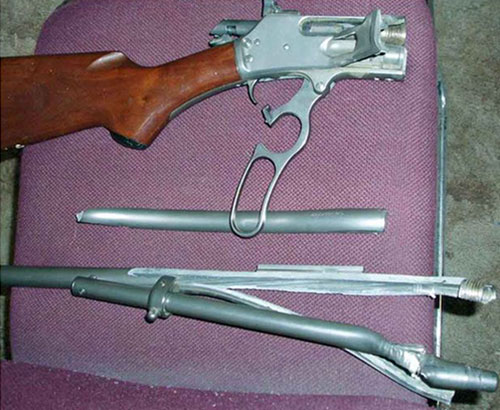
This is what can happen when one uses a too-mild primer. Here, the combination of a light charge with a hard-to-ignite propellant, a mild primer, and shooting on a cold day all contributed. Regardless of what you might think, conversion of this custom rifle into these useless pieces resulted from a detonation with a charge that normally would have generated relatively mild pressure.
I compared results with various primers. Contrary to what many loading manuals suggest, for full-power loads in a gun with modest striker energy (most non-bolt-action guns), the CCI-300 is ideal for loads using extruded propellants and the CCI-350 is ideal for loads using ball-type propellants. For loads with A5744, the Remington 2½ is ideal. However, in all loads, primer choice can be tricky, and use of the wrong primer can lead to a catastrophe.
Through the years, I fired thousands of rounds through my original Marlin 45-70, both at paper and while plinking at long-range targets. Excepting my varminting guns and my old 22 rimfire Stevens pump, I have never fired, and never will fire, as many rounds through any other rifle. Through all that shooting, I learned considerably about what the 45-70 can do.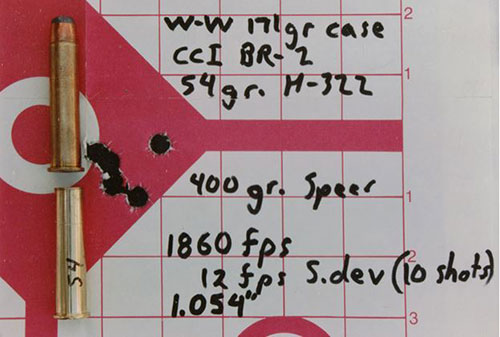
While this load has all the accuracy one could ever want for hunting with a 45-70, this Speer bullet is the worst possible choice. Speer designed it to give good expansion when fired at blackpowder velocity from the Trapdoor Springfield, a gun from which no one should ever fire any jacketed bullet (the bore steel is so soft that such bullets cause rapid erosion). Literally, the 400-grain Speer JFN is the ideal hunting bullet for use in a gun in which it should never be used. The logic behind this bullet escapes me entirely.
In the era of its original development, the US Military was facing Indians who used a tactic of firing arrows at a high angle so they would come down almost vertically behind any close-range barricade where soldiers might be hiding. With skilled archers and plenty of arrows, that was an effective technique.
My memory on this is dim but I do recall either reading or being told by a mentor that the US Military wanted a gun and load with the same capability. Therefore, this was a consideration in development of the 45-70. I do not know whether or not this was true or if this technique was ever used with any success in any battle.
I do know that the original blackpowder 45-70-500 loading could deliver mortal energy to targets beyond 1700 yards (375 foot-pounds at one mile, more than a 45 Automatic generates at the muzzle). At maximum horizontal range for level fire (2179 yards at sea level with standard atmospheric conditions), that bullet arrives with about 189 foot-pounds of energy, which is certainly sufficient to generate lethal damage.
All the way to maximum horizontal distance, that bullet was still accurate. The published claim was that the 500-grain round nose would penetrate 17-inches of loose sand at 1700 yards, but until I personally test that I will remain skeptical. Nevertheless, the 45-70-500 remains the most effective long-range military battle rifle cartridge ever adopted by the US because the bullet always remains stable throughout its ballistic flight (no standard bullet fired from any more modern military cartridge will do so). Because of this, the 500-grain round nose shoots accurately to almost twice as far as any bullet does in any other US battle cartridge.
Brian Pierce used a heavy hard-cast bullet in this Marlin 45-70 to cleanly dispatch not one, but two Cape buffalo with one shot. The first was a full-grown cow; the second was a yearling that happened to be standing directly behind the cow. I will not detail that story here but I will note that it happened not because Pierce was careless but because his guide simply refused to believe that any lever-action cartridge and load could possibly launch a bullet that would fully penetrate any Cape Buffalo. The guide insisted that he shoot. So, Pierce shot. The guide had to pay for the second kill.
Many blackpowder target shooters use rifles chambered in 45-70 for blackpowder silhouette and other games where the power, accuracy, and ease of finding an accurate load and of loading such ammunition are all important. Many shooters who compete in the Friends of Billy Dixon match at our range near Hotchkiss Colorado shoot the 45-70, with good results. 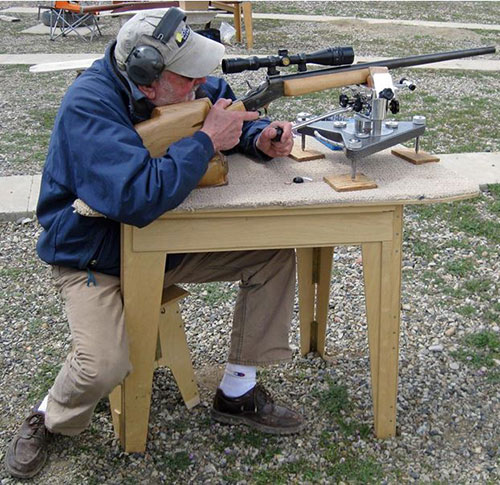
Friends of Billy Dixon Range, shooting line: The late By Smalley, shooting the Rolling Block action that he barreled, stocked, and otherwise modified for use with the 45-70 at the Friends of Billy Dixon Range. Using this rifle and his custom 45-70 handload and a bullet that he and I designed, Smalley fired four shots that went inside an 18-inch high by 42-inch wide rectangle, at 1538 yards. At that distance, tiny wind changes will move the bullet many feet. That accuracy pales when compared to the ten-shot 45-70 group fired by a Credemore competitor in 1886. He put all ten bullets inside an 8.6-inch circle, at 1000 yards.
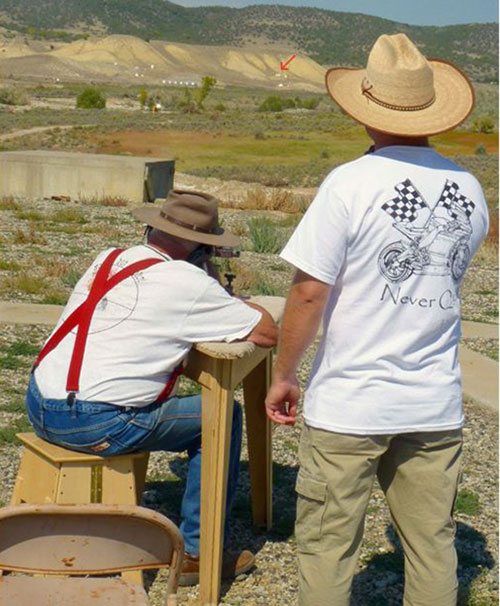
Smalley shooting his 45-70 during the Friends of Billy Dixon event, with Andy Tuttle observing: Superimposed red arrow points at the official FoBD target, see preceding picture. Other steel targets include various animal silhouettes and diamond and round gongs scaled to present precise visual sizes in terms of MOA distended.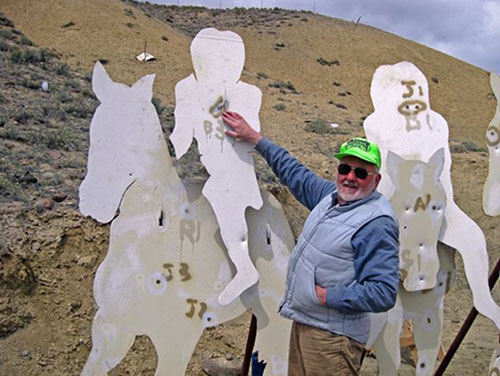
Smalley pointing to his winning, first-shot-during-competition, hit. First time anyone ever hit one of the suspension hangers.
Because the 45-70 chambering was never intended for use with paper-patched bullets, chamber design does not suffer the limitations that chambers for many other surviving cartridges of the same era do (refer to my treatise on the 38-55 WCF). Therefore, cases and chambers matching the original design work well with loads using modern swaged, jacketed, and cast bullets.
The unexpected change in SAAMI maximum cartridge length of the 45-70 that I believe occurred when manufacturers dropped the 500-grain loading after the end of World War Two (when US makers resumed production of ammunition for the civilian market), facilitated adoption of the 45-70 to the Marlin 336 action. (This was the basic design of 1893 that Marlin built for the 32-40 and 38-55, which was the Marlin action designed for cartridges of about 2½-inch length.)
In 1972, Marlin took advantage of this possibility with the introduction of what it called the 1895 (in honor of the original Model of 1895, which was the Marlin action designed for cartridges of about 2¾ inches.) Introduction of the new Marlin 1895, more than all other factors combined, is responsible for the current popularity of the 45-70.
Despite the fact that the 45-70 is very nearly the perfect antithesis of the modern rifle cartridge, it does so many things so well that it will persist as a popular and useful chambering for as long as folks keep shooting cartridge guns. The 38-55 is far more pleasant to shoot but does not have the authority that the 45-70 has. When loaded with blackpowder, the 50 WCF is a far more effective hunting cartridge than the 45-70 is, but the disadvantages of the 50 WCF far outweigh that single advantage. When loaded to standard overall cartridge length using blackpowder, the 45-90 has a significant ballistic edge for long-range target shooting, but if one modifies the 45-70 chamber to allow use of cartridges with the bullet seated shallower, that difference almost disappears. And, when compared to the 40-65 and all other cartridges of the same class, the 45-70 has the overall edge.
While some might argue that the military origin of this chambering has much to do with its continued popularity, I believe that it is fair to suggest that beyond the first century any such history can no longer explain the continued popularity of any cartridge. In that regard, I will make the following observation; the 30-06 Springfield no longer holds sway as one of the most popular chamberings for any application. While it is still a very good cartridge, in the past 30 years or so while the 45-70 gained in popularity, the 30-06 lost considerable ground to cartridges of more-modern design.
Conclusions: To merely suggest that the 45-70 is here to stay would be akin to damning it with faint praise. The 45-70 is not only here to stay but while many chamberings that were popular in my youth have disappeared and others are fading away as I write this treatise the 45-70 continues to gain in popularity. I see no end to that trend.
About the Author: M. L. (Mic) McPherson
Mic McPherson’s passionate pursuit of answering the question: “Does an ideal case design exist?” in part led him to be an accomplished and respected author and a thought leader in the firearm, shooting, and handloading communities.
McPherson has done ballistic testing in many laboratories, including: Oehler, Norma, Sierra, Speer, Western, Accurate, Hodgdon, and Hornady. He attended the prestigious Oehler Research Pressure Testing Seminar where he demonstrated the surprising degree to which charge position matters.
McPherson is co-holder of four patents on optimized cartridge design. These parametric patents cover the physics behind what represents optimum cartridge design, as measured by ballistic efficiency. These also address the theory and mathematical constructs needed to understand how to design an optimum cartridge and how to measure the efficiency of such a cartridge.
McPherson is the author of Accurizing the Factory Rifle, a best-selling guide to gunsmithing; Metallic Cartridge Handloading, the modern bible on handloading; Zigzag Canyon, Book-of-the-year for the Zane Gray Society; Cartridges of the World, 8th and 9th Editions, and various other books. He has had hundreds of articles published in various magazines, including: Precision Shooting, The Accurate Rifle, Guns, American Rifleman, Very High Power, and Varmint Hunter.
McPherson served as Editor of Reloading for Shotgunners, 4th Edition, and Handloader’s Digest. He has also been a contributing author for Handloader’s Digest, Gun Digest, and other gun-industry publications.
Disclaimer: This article was written to provide historical perspective on the 45-70 case, none of the handloads that I mention herein, either directly or indirectly, represent a handloading recommendation to anyone for any purpose. I make no claim as to the safety of any load discussed in this piece for any application. These are loads used by others and myself, in our guns, created with our components and our loading tools. Any specific data that I discuss or reference (either directly or indirectly) in this article might or might not be safe in any particular gun: Explicitly, most of these loads would be unsafe for use in many older and even some newer 45-70 chambered guns. If you intend to handload for your 45-70, use only data presented in a modern loading manual, and follow all instructions associated with that data, as to specific components, loading details, and load development. For original military and related civilian rifles chambered in 45-70 that are known to be metallurgically and mechanically sound, the only assuredly safe loads combine a full charge of FFg blackpowder and a cast or swaged-lead bullet (jacketed bullets will erode the bore very rapidly). Many of these original guns are in questionable condition and the best approach, could well be to assign such a gun to the wall-hanger category: Interesting to look at and handle but best left unfired.
